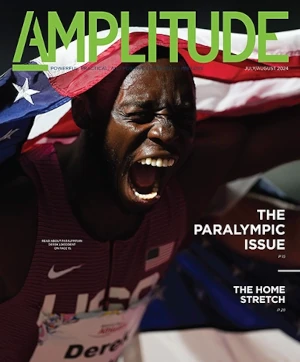
About a decade ago, as the Affordable Care Act was rolling out, a study revealed that artificial hips—which US hospitals typically priced at $10,000 or more in hip-replacement surgeries—cost about $350 per unit to manufacture.
That factoid was one among many examples of irrational pricing that came to light as policymakers struggled to reform the healthcare marketplace. It reminds us that extravagantly priced prosthetic devices—whether internal ones like hip implants, or external ones such as bionic legs—are nothing new. And it provides a bit of useful context for this issue’s feature about the factors that contribute to the high cost of prosthetic limbs.
Amplitude learned that a typical microprocessor knee costs about $2,500 to manufacture but likely appears as a roughly $30,000 charge on the claim your prosthetic clinic files with your insurer. Our article describes a few of the cost escalators that drive the price upward between the factory and your body. Some of those dynamics seem reasonable; others seem incomprehensible.
But none of them are set in stone. They all reflect choices that have been made (or not made) over the years. Alternative choices could be made going forward that might create a more customer- friendly pricing structure—especially if consumers get to participate in shaping those decisions. At present, amputees have little to no negotiating leverage in the prosthetics marketplace. As long as that remains the case, prices are never going to respond to their needs and wants.
There’s a valid argument that bionic legs should be expensive, because the ability to walk has incalculable value; you can’t price it as if it were a smartphone or a refrigerator. But other assistive technologies that restore basic physical capacities—such as prosthetic teeth and hearing aids—are marketed as fairly conventional commodities and exposed to conventional market pressures. That’s not to say such technologies are cheap. But they’re less insulated from consumer demand than the prosthetics marketplace seems to be.
What would a more rational prosthetics marketplace look like, and how do we get there? Amplitude doesn’t have the answers. We’d just like to see a healthy, constructive debate around these questions, and we’d like amputees to have a voice in it. Hopefully our article can help advance the conversation. It’s titled “Playing the Market,” and it starts on page 12.
Elsewhere in this issue, we convene a discussion about whether there’s a catchier name for Limb Loss and Limb Difference Awareness Month (“Brand Awareness,” page 5). We ask if the costs of traveling hundreds of miles for limb care can ever be outweighed by the benefits of seeing a compatible prosthetist (“Ain’t No Mountain High Enough,” page 28). We consider not only the “hows” but also the “why’s” of traveling as an amputee (“Redefining Accessible Travel,” page 18). And we introduce you to Hugh Herr’s scientific method for building the optimal socket and liner (“Skins in the Game,” page 24).
All that, plus the arrival of spring. Enjoy the issue!




